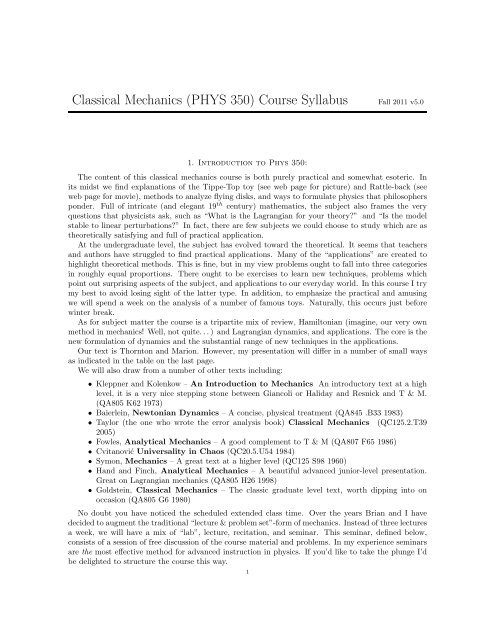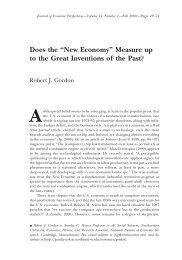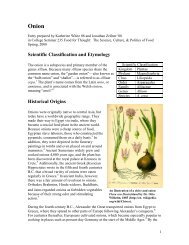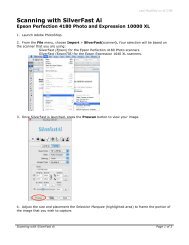Classical Mechanics (PHYS 350) Course Syllabus - Academics
Classical Mechanics (PHYS 350) Course Syllabus - Academics
Classical Mechanics (PHYS 350) Course Syllabus - Academics
Create successful ePaper yourself
Turn your PDF publications into a flip-book with our unique Google optimized e-Paper software.
<strong>Classical</strong> <strong>Mechanics</strong> (<strong>PHYS</strong> <strong>350</strong>) <strong>Course</strong> <strong>Syllabus</strong> Fall 2011 v5.0<br />
1. Introduction to Phys <strong>350</strong>:<br />
The content of this classical mechanics course is both purely practical and somewhat esoteric. In<br />
its midst we find explanations of the Tippe-Top toy (see web page for picture) and Rattle-back (see<br />
web page for movie), methods to analyze flying disks, and ways to formulate physics that philosophers<br />
ponder. Full of intricate (and elegant 19 th century) mathematics, the subject also frames the very<br />
questions that physicists ask, such as “What is the Lagrangian for your theory?” and “Is the model<br />
stable to linear perturbations?” In fact, there are few subjects we could choose to study which are as<br />
theoretically satisfying and full of practical application.<br />
At the undergraduate level, the subject has evolved toward the theoretical. It seems that teachers<br />
and authors have struggled to find practical applications. Many of the “applications” are created to<br />
highlight theoretical methods. This is fine, but in my view problems ought to fall into three categories<br />
in roughly equal proportions. There ought to be exercises to learn new techniques, problems which<br />
point out surprising aspects of the subject, and applications to our everyday world. In this course I try<br />
my best to avoid losing sight of the latter type. In addition, to emphasize the practical and amusing<br />
we will spend a week on the analysis of a number of famous toys. Naturally, this occurs just before<br />
winter break.<br />
As for subject matter the course is a tripartite mix of review, Hamiltonian (imagine, our very own<br />
method in mechanics! Well, not quite. . . ) and Lagrangian dynamics, and applications. The core is the<br />
new formulation of dynamics and the substantial range of new techniques in the applications.<br />
Our text is Thornton and Marion. However, my presentation will differ in a number of small ways<br />
as indicated in the table on the last page.<br />
We will also draw from a number of other texts including:<br />
• Kleppner and Kolenkow – An Introduction to <strong>Mechanics</strong> An introductory text at a high<br />
level, it is a very nice stepping stone between Giancoli or Haliday and Resnick and T & M.<br />
(QA805 K62 1973)<br />
• Baierlein, Newtonian Dynamics – A concise, physical treatment (QA845 .B33 1983)<br />
• Taylor (the one who wrote the error analysis book) <strong>Classical</strong> <strong>Mechanics</strong> (QC125.2.T39<br />
2005)<br />
• Fowles, Analytical <strong>Mechanics</strong> – A good complement to T & M (QA807 F65 1986)<br />
• Cvitanović Universality in Chaos (QC20.5.U54 1984)<br />
• Symon, <strong>Mechanics</strong> – A great text at a higher level (QC125 S98 1960)<br />
• Hand and Finch, Analytical <strong>Mechanics</strong> – A beautiful advanced junior-level presentation.<br />
Great on Lagrangian mechanics (QA805 H26 1998)<br />
• Goldstein, <strong>Classical</strong> <strong>Mechanics</strong> – The classic graduate level text, worth dipping into on<br />
occasion (QA805 G6 1980)<br />
No doubt you have noticed the scheduled extended class time. Over the years Brian and I have<br />
decided to augment the traditional “lecture & problem set”-form of mechanics. Instead of three lectures<br />
a week, we will have a mix of “lab”, lecture, recitation, and seminar. This seminar, defined below,<br />
consists of a session of free discussion of the course material and problems. In my experience seminars<br />
are the most effective method for advanced instruction in physics. If you’d like to take the plunge I’d<br />
be delighted to structure the course this way.<br />
1
2<br />
2. Seminars:<br />
My Platonic Ideal of The Seminar: The professor provides a detailed syllabus of a subject which,<br />
if followed carefully, will build a solid foundation of the subject. The students, working together with<br />
the professor, learn and present the material in class in a way which is clear to everyone. Discussion is<br />
active, intellectually challenging, non-threatening, and pushes the envelope of everyones understanding.<br />
In preparation every member has no problem asking others about a solution, an integral, or definition<br />
whether it is in class or in the dining halls. In seminar any remaining questions are discussed in depth<br />
resulting in new insights which, naturally, arrive with a blinding flash of light.<br />
The typical seminar consists of a series of solutions and 10-15 minute presentations punctuated by<br />
discussion. We all contribute but I emphasize the complete reversal of roles. You take an active role<br />
in teaching yourselves. It is your class! There is but one rule: Except for your final toy presentation<br />
when you may use it if you’d like, there will be no PowerPoint presentations.<br />
Here are a few suggestions to help you along. Slogans lead the more detailed descriptions.<br />
(1) Start early. Work slowly and carefully. Nothing will help you better than to start preparing for<br />
seminar early. As good as they are, these chapters are not short stories; it would be unpleasant<br />
to read the entire chapter in one sitting. Further, read with a scratch pad and writing utensil;<br />
work through the presentation of the text. Schedule in plenty of time.<br />
(2) Do all the problems. Dance is not learned by only watching a video; physics is not learned by<br />
only reading. To learn the subject one must try out the stuff by talking and writing about it<br />
and working through problems. For many of us this process has two purposes. One is to gain<br />
mathematical fluency. The other is to find the physics in the mathematics.<br />
(3) Minimize frustration!’ One of the aspects of the seminar experience that took me the longest<br />
to learn was the utility of asking a question. If you encounter difficulty, carefully formulate a<br />
question (often the question answers itself in this process!), then ask someone. If this person is<br />
madly preparing a midterm or a French buttercream or does not know the answer, try someone<br />
else. In particular do not hesitate to ask me (Science G052, x4919, smajor). If all else fails, go<br />
on to other problems and return to the question later.<br />
(4) Write clean and clear solutions When writing solutions keep in mind that there is also a large<br />
difference in sketching a solution on your napkin at dinner and writing up the solution so that<br />
someone can read it (and that may include you!) As with much writing, keep your audience in<br />
mind. Keep your classmates in mind but also try thinking of yourself in 3 months. The logical<br />
argument of your solution should be clear on a first read.<br />
(5) For presentations: Be clear. To impress, exhibit novelty. Much of what is true for solutions<br />
also applies to presentations. Clearly state the issue or problem, outline the tools needed, and<br />
proceed providing information when needed. Feel free to skip algebraic steps once you have<br />
cleared it with the class. Show us (including me) something we don’t already know, e.g. a new<br />
numerical solution or a experimental manifestation of a problem.<br />
(6) Preserve class notes The best policy is to prepare fully for seminar before we meet and write<br />
up summaries and/or complete solutions after the actual seminar. It is not easy to keep up.<br />
But your notes will be loads of help for graduate school classes, qualifying exams, and even<br />
when you teach this course! Think of this as writing up notes from which you can relearn the<br />
subject.<br />
(7) Be clear about what you understand and what you don’t It is never too early (or too late) to<br />
start being clear about what you understand and what you do not. There is a vast, amorphous<br />
plain between familiarity and understanding. Question your own understanding by trying it<br />
out on new situations. If your knowledge is not what is required, find the difference and learn<br />
from it.
(8) Make a formula sheet If you haven’t already started, start keeping a sheet of paper with useful<br />
formulae so you can quickly answer questions such as, what is the spherical coordinate volume<br />
element?<br />
3. Text:<br />
Thornton and Marion, <strong>Classical</strong> Dynamics of Particles and Systems 5th edition.<br />
4. Colloquium:<br />
On a few Mondays (and a Thursday) during the semester we will have speakers from other colleges<br />
and universities come a speak on their research. Please make every effort to attend these; they give<br />
you an idea about the sort of research that is done and they are part of your physics education.<br />
5. <strong>Course</strong> info:<br />
All materials will be available online. You can find them through the <strong>Course</strong>s tab on my homepage<br />
http://academics.hamilton.edu/physics/smajor/index.html. The latest versions will be labeled by a<br />
version number in the top right of the first page.<br />
6. Grades:<br />
There are 3 parts to the grade:<br />
(1) Problem sets, labs and seminar participation (50 %): Weekly-ish assignments will be posted<br />
and distributed at least one week prior to the due date. I encourage you to work together you<br />
but must write up your own solutions. If you received a significant idea from someone else or<br />
another source, please cite them. I highly recommend that you grapple with a problem before<br />
you look for help from me, your classmates, or online. Your presentations will be assessed for<br />
clarity and novelty.<br />
(2) Mid-term: (20 %) The exam will be Friday, October 7.<br />
(3) Final (30 %): The final will take place at the regular scheduled time for MWF 1 PM classes,<br />
Wednesday December 15 9-12.<br />
7. Weekly Schedule<br />
Given how the semester starts, the “week” starts on a Thursday. What follows is preliminary!<br />
Enjoy!<br />
Seth Major<br />
Science G052<br />
x4919<br />
smajor@hamilton.edu<br />
3
4<br />
Week Topic Reading<br />
26 August Newtonian <strong>Mechanics</strong> I: Point particle Ch 2 (42 pages)<br />
2 September Newtonian <strong>Mechanics</strong> II: Rockets & Gravitation Ch 5 and 9.11 (29 pages)<br />
9 September Oscillations and Phase Space Ch 3.1-3.8 (30 pages)<br />
16 September Non-linear Oscillations Supplements<br />
23 September New Tools I: Calculus of Variations Ch 6 (19 pages)<br />
30 September New Tools II: Lagrangian & Hamiltonian Dynamics Ch 7.1-11 (44 pages)<br />
7 October Dynamics problems Exam Ch 7.12 -7.13 (8 pages)<br />
14 October Fall break<br />
21 October Central Force Motion Ch 8 (36 pages)<br />
28 October Systems of Particles Ch 9.1-9.10 (43 pages)<br />
4 November Systems of Particles continued Ch 9.1-9.10 (43 pages)<br />
11 November Non-inertial reference frames Ch 10 (21 pages)<br />
18 November Dynamics of Rigid Bodies Ch 11 ( 20 pages)<br />
25 November Thanksgiving No classes<br />
2 December Coupled Oscillations Ch 12 ( 28 pages)<br />
6 December Toy Week! (and review, too) Projects<br />
15 December Final Wednesday 9 - 12






